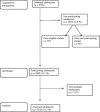Main characteristics and participation rate of European adolescents included in the HELENA study
- PMID: 22958310
- PMCID: PMC3490738
- DOI: 10.1186/0778-7367-70-14
Main characteristics and participation rate of European adolescents included in the HELENA study
Abstract
Background: Participation rate and response rate are key issues in a cross sectional large-scale epidemiological study. The objective of this paper is to describe the study population and to evaluate participation and response rate as well as the key nutritional status variables in male and female adolescents involved in the HELENA study.
Methods: A multi-stage random cluster sampling with a target sample of 3000 adolescents aged [12.5 to 17.5] years, stratified for geographical location and age, was carried out. Information for participants and non-participants (NP) was compared, and participation and response rates to specific questionnaires were discussed.
Results: 3,865 adolescents aged [12.5 to 17.5] years (1,845 females) participated in the HELENA study, of whom 1,076 (568 females) participated in the blood sampling. 3,528 (1,845 females) adolescents were finally kept for statistical analysis. Participation rates for the schools and classes differed importantly between countries. The participation rate of pupils within the participating classes also differed importantly between countries. Sex ratio, mean age and BMI were similar between NP and participating adolescents within each centre, and in the overall sample. For all the questionnaires included in the database, the response rate of questionnaires was high (more than 80% of questions were completed).
Conclusion: From this study it could be concluded that participation rate differed importantly between countries, though no bias could be identified when comparing the key study variables between participants and non-participants. Response rate for questionnaires was very high. Future studies investigating lifestyle and health in adolescents can optimize their methods when considering the opportunities and barriers observed in the HELENA study.
Figures
References
-
- Weiss R, Dufour S, Taksali SE, Tamborlane WV, Petersen KF, Bonadonna RC. et al.Prediabetes in obese youth: a syndrome of impaired glucose tolerance, severe insulin resistance, and altered myocellular and abdominal fat partitioning. Lancet. 2003;362:951–957. doi: 10.1016/S0140-6736(03)14364-4. - DOI - PMC - PubMed
LinkOut - more resources
Full Text Sources
Miscellaneous


